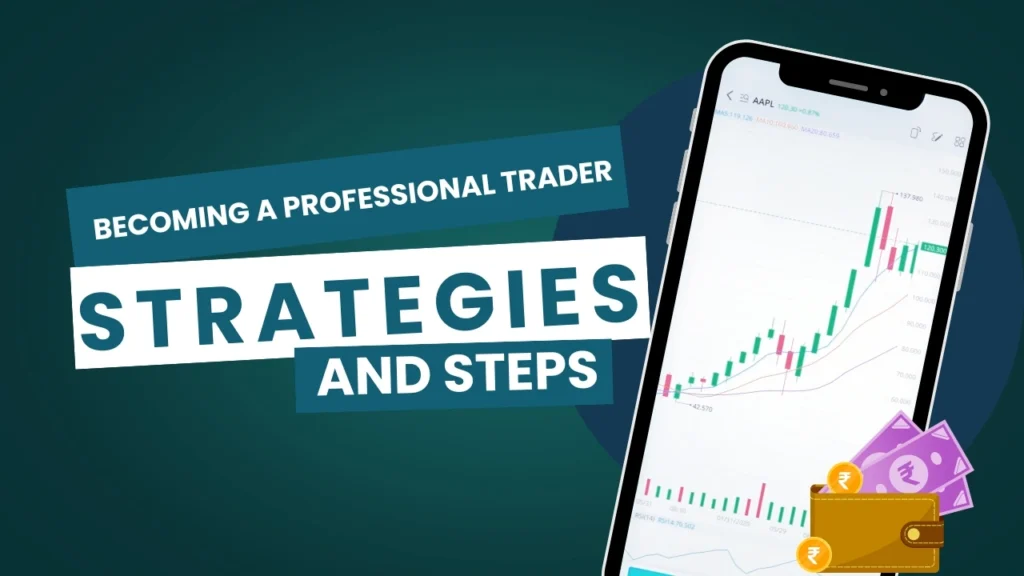The Road to Becoming a Professional Trader: Many people in the financial market are traders with a specific goal of becoming professional traders. However, this journey requires dedication, knowledge, and strategic planning. Here in this post, we will know what steps are necessary to become a professional trader and what strategies should be adopted by the trader.
Understanding the Basics
Before understanding the nuances of trading learn about to the good understanding of the basics such as learning about financial markets, different asset classes such as stocks, forex, commodities, etc., trading terminology, and market analysis techniques.
Education and Continuous Learning
Education is the most important pillar of becoming a pro trader. Start by reading books of famous traders, attending webinars of professional traders, and taking online courses by reputed institutes.
Develop a Trading Plan
A foolproof trading plan is essential for success in the financial market with a trading setup. Your plan should include how much is your trading profit goals, how much you can take risk, Preferred trading style that is suitable for you like Day trading, Swing trading, or Long-Term investing), A detailed strategy for entering and exiting trades.
Risk management
Risk management is the key to success in trading. Because most of the traders don’t know how much risk they can take. Never risk more than a small percentage of your trading capital on any single trade. Most of the traders wipe out their entire capital in a few trades. They follow the process of booking small profits and big losses. Always use stop loss in every single trade and diversify your portfolio to spread risk across different assets.
Reliable Brokerage
Always choose a reliable brokerage firm for trading. Most of the brokerages provide you tips for trading so that they earn brokerage charges from users. For a few years, there are many brokerage firms have been available with different key features, different competitive fees, reliable customer support and trading tools.
Master Technical and Fundamental Analysis
Technical analysis involves studying price charts and patterns to identify trading opportunities, while fundamental analysis focuses on evaluating the financial health and prospects of companies or assets. A professional trader combines both approaches to make well-informed trading decisions. Some to traders suggest that technical analysis is better than fundamental analysis but knowledge of the fundamentals of stocks or instruments that you are trading gives you an edge.
Practice with a Demo Account
There are many trading software available for practice paper trading. Use them to understand how price movement works in trading. Do not risk real money directly. Paper trading allows you to gain experience and refine your skills without incurring losses. But there is a negative side of paper trading that this does not give you exact emotions of real money.
Build a Trading Routine
Trading is the game of Consistency. Develop a trading routine that includes regular market analysis, monitoring economic news and events, and reviewing your trades to identify strengths and areas for improvement. Always analyze stocks a day before you want to trade in non-trading hours.
Embrace Continuous Improvement
A trader is always ongoing in a journey. You as a trader always find yourself as a learner. Market moves are always unexpected and give a different learning. Always learn from the market and Stay updated with market trends, learn from experienced traders, and adapt your strategies as needed. Keep a trading journal to track your progress and learn from both successful and unsuccessful trades.
Network and Seek Mentorship
Keep in touch with a trading community because other traders can provide valuable insights and guidance. Always analyze what kind of good things they are doing and what kind of mistakes are doing because in the financial market every mistake is chargeable. So learn from other’s mistakes.
Stay Disciplined and Patient
Trading requires discipline, patience, and emotional control. Avoid impulsive decisions based on emotions like fear or greed. Stick to your trading plan, accept losses as part of the learning process, and stay focused on your long-term goals.
Also Read: Why Do Most People Choose Trading as a Career and Fail?
Conclusion
The Road to Becoming a Professional Trader is a challenging yet rewarding journey that requires dedication, education, and continuous improvement. By understanding the basics, developing a solid trading plan, mastering analysis techniques, and staying disciplined, you can increase your chances of success in the competitive world of trading. Remember, consistency and persistence are key virtues on this path to professional trading.




Pingback: Types of Analysis in the Financial Market - stoxnake.com
Pingback: Trading: A Brief Understanding - stoxnake.com